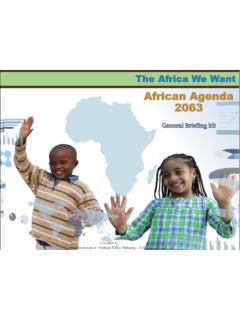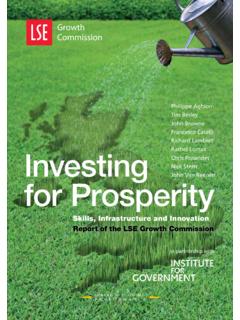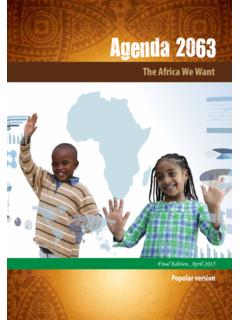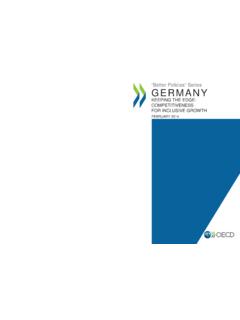Transcription of EWS - Reos Partners
1 DEEPERNEWSDEEPERNEWSThe Mont Fleur ScenariosWhat will South Africa be like in the year 2002?with a new introduction by Mont Fleur facilitator, Adam KahaneVOLUME7 NUMBER1 VOLUME7 NUMBER1 DEEPERNEWSEDITORSJ enny BeeryEsther EidinowNancy MurphyARTDIRECTORPete Allen CockeADDRESSG lobal Business Network5900-X Hollis StreetEmeryville CA ANDSUGGESTIONSN ancy Mont Fleur ScenariosDEEPERNEWS (formerly pub-lished as THE DEEPERNEWS ) is a series of articlespublished by Global BusinessNetwork DEEPERNEWSand THE DEEPERNEWS are registered trade-marks of Global BusinessNetworkScenario thinking as a way of approaching thefuture is increasingly being used as a tool forstrategizing in private and public sector organi-zations.
2 The Mont Fleur scenario exercise, undertak-en in South Africa during 1991 92, was innovativeand important because, in the midst of a deep con-flict, it brought people together from across organiza-tions to think creatively about the future of theircountry. This Deeper Newspresents the Mont Fleurscenarios as they were originally published in theSouth African newspaper The Weekly Mail& TheGuardian Weekly, in July 1992. We hope this newintroduction will provide a useful overview of the pro-ject, reflecting on its effects and the broader insights ithas and ParticipantsThe historical context of the project is important tounderstanding its impact.
3 It took place during theperiod between February 1990, when NelsonMandela was released from prison, and the AfricanNational Congress (ANC), Pan African Congress(PAC), South African Communist Party (SACP), andother organizations were legalized, and April 1994,when the first all-race elections were held. Duringthese years, dozens of forums were set up in SouthAfrica, creating temporary structures that gatheredtogether the broadest possible range of stakeholders(political parties, civic organizations, professional bod-ies, government departments, trade unions, businessgroups, etc.)
4 To develop a new way forward in a par-ticular area of concern. There were forums to discusseducation, housing, economic policy, constitutionalmatters, and many other areas. They ranged frominformal, off-the-record workshops to formal, publicnegotiations. The Mont Fleur project was one type offorum that, uniquely, used the scenario purpose of Mont Fleur was not to present defin-itive truths, but to stimulate debate on how to shapethe next 10 years. The project brought together adiverse group of 22 prominent South Africans politicians, activists, academics, and businessmen,from across the ideological spectrum to develop anddisseminate a set of stories about what might happenin their country over 1992 2002.
5 (For a full list ofparticipants and their affiliations at the time, see page21 of this Deeper News.)Summary of the ScenariosThe scenario team met three times in a series ofthree-day workshops at the Mont Fleur conferencecenter outside Cape Town. After considering manypossible stories, the participants agreed on four sce-narios that they believed to be plausible and relevant: Ostrich, in which a negotiated settlement tothe crisis in South Africa is not achieved,and the country s government continues tobe non-representative Lame Duck, in which a settlement isachieved but the transition to a new dispen-sation is slow and indecisive Icarus, in which transition is rapid but thenew government unwisely pursues unsus-tainable, populist economic policies Flight of the Flamingos.
6 In which the govern-ment s policies are sustainable and the coun-try takes a path of inclusive growth anddemocracyThe group developed each of these stories into a brieflogical narrative. A fourteen-page report was distrib-uted as an insert in a national newspaper, and a 30-minute video was produced which combined cartoonswith presentations by team members. The team thenpresented and discussed the scenarios with more thanfifty groups, including political parties, companies,academics, trade unions, and civic organizations. Atthe end of 1992, its goals achieved, the project waswrapped up and the team the Project Was and Was NotThe ideas in the Mont Fleur team s four scenarioswere not in themselves novel.
7 What was remarkableabout the project was the heterogeneous group ofDEEPERNEWS1 Learning from Mont FleurScenarios as a tool for discovering common groundimportant figures delivering the messages, and howthis group worked together to arrive at these approach was indirect and the results subtle: Mont Fleur did not resolve the crisis inSouth Africa. The project, along with other,non-scenario forum processes, contributedto the establishment of a common vocabu-lary and mutual understanding. The sharedlanguage of Mont Fleur extended beyondthe negotiating elite, and was thus able toinclude such dialogues as an exhortation toFlamingos in a Sunday church sermon and aconcern raised about Lame Duckon a ruralradio phone-in.
8 This kind of commonunderstanding, together with many otherfactors, promoted agreement upon a settle-ment to the crisis. The participants did not agree upon a con-crete solution to the country s reached a consensus on some aspectsof how South Africa worked, on the com-plex nature of the crisis, and on some of thepossible outcomes of the current specifically, they agreed that, given theprevailing circumstances, certain stronglyadvocated solutions could not work, includ-ing armed revolution, continued minorityrule (Ostrich), tightly circumscribed majorityrule (Lame Duck), and socialism (Icarus).
9 Asa result of this process of elimination, thebroad outline of a feasible and desirable out-come emerged (Flamingos). The process was not a formal, mandatednegotiation. Rather, it was an informal,open conversation. At the first workshop,some of the participants expected toencounter difficulties in agreeing on any-thing. Over the course of the meetings,they talked until they found areas of sharedunderstanding and agreement, several ofwhich were relevant to the formal negotia-tions which were occurring simultaneously. It did not deal with the differences amongthe participants.
10 Negotiation tends to focuson identifying the positions and interests ofthe parties and then finding a way to narrowor reconcile these differences. The MontFleur process, in contrast, only discussed thedomain that all of the participants had incommon: the future of South Africa. Theteam then summarized this shared under-standing in the scenarios. The aim of suchnon-negotiating processes is, as MarvinWeisbord, an organizational consultant, hasstated, to find and enlarge the commonground. Results from the ProjectThe Mont Fleur project produced several differenttypes of results: substantive messages, informal net-works and understandings, and changed ways ofthinking.




